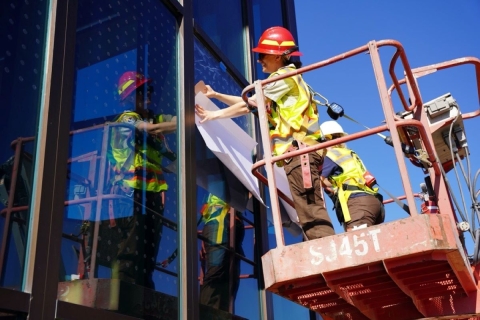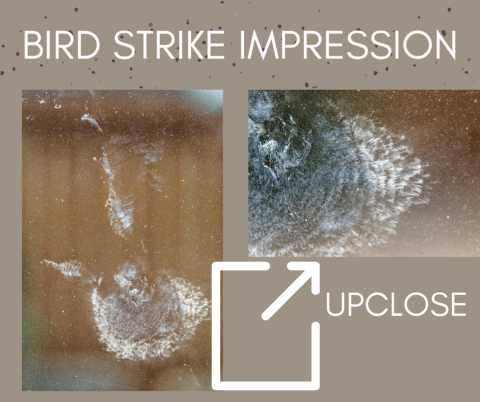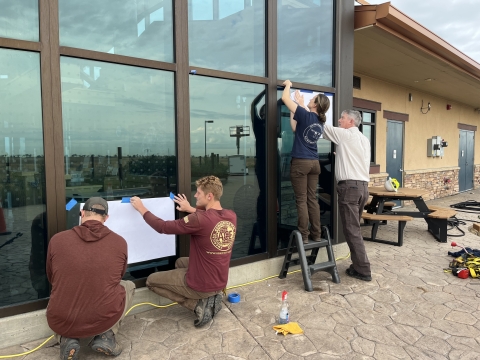Rocky Mountain Arsenal National Wildlife Refuge, Colorado - Nearly invisible to the naked eye, dotted patterns are applied to the glass of the Visitor Center at the Rocky Mountain Arsenal National Wildlife Refuge. While unassuming, these patterns are critical to the mission of the Refuge and the Migratory Birds Program as a whole.
Using long strips, employees applied the dots to the glass in tight patterns, leaving just two inches between each dot. This tight spacing allows for even the smallest of our feathered friends, like hummingbirds, to detect the glass.
Touting hard hats and high- visibility vests, staff convened at the Visitor Center for the installation. A variety of Service employees, including permanent and temporary refuge employees, American Conservation Experience interns, Refuge Manager David Lucas, Deputy Refuge Manager Megan Klosterman, and Regional Migratory Bird Program staff worked together to ensure this important work could get accomplished. Some individuals bravely volunteered to reach the windows on the third level, ensuring that all potential sites of bird collisions would be covered.
Thanks to this crew - many of them braving the heights to reach the top of the three-story windows - the Refuge Visitor Center windows are no longer a threat to birds.
Nearly One Billion Birds a Year
When a human walks into glass, often the result is a semi-viral video and, in the aftermath, someone to clean up the smudges. Apart from extreme circumstances, many of us will walk away embarrassed but mostly unharmed. Often, we will see the glass and stop or turn to avoid a collision, but if we’re not paying attention, we’ll likely walk away with more bruises to our egos than our bodies.
However, it’s an entirely different story for birds. Birds don't see the world the way we do and are unable to identify the glass. Instead, they see the reflection of their habitat, including trees and shrubs. The maze of multi-story glass buildings and chic floor-to-ceiling windows found in urban areas (over 80% of Americans live in urban areas) are, to birds, dangerous and often fatal barriers to migration.
As a result of rapid urbanization, nearly one billion birds collide with glass in the U.S. every year. When birds crash into glass, they often do so fatally—much more akin to a car crash. When wildlife rehabilitators recover stunned and injured birds, the injuries are often so grave that 60% of birds succumb to their injuries. Often, birds suffer head trauma and concussions from striking a window—and even when they’re able to fly away in the moment, many are later found dead. As conservation practitioners began to understand the scale of the issue and how many birds have been affected, the Service got to work right away by identifying high-risk facilities and finding funding to upgrade or retrofit structures. The Service also has been connecting with cities across the nation in the Urban Bird Treaty Program to retrofit glass structures with bird-safe glass, among other efforts to make cities more bird-friendly.
The Urban Wildlife Conservation Program is guided by Standards of Excellence, one of which being Modeling Sustainability. It is a hope shared by all Service employees that our efforts and leadership in conservation serves as a model for others to follow.
The Installation
The Service is committed to ensuring our facilities embrace the principles of sustainability and hold ourselves accountable to standards of excellence. It is a hope shared by all Service employees that our efforts and leadership in conservation serves as a model for others to follow.
Despite the challenges —including reaching the tops of their tall, angled windows—staff at Rocky Mountain Arsenal ensured that their Visitor Center windows were completely retrofitted with bird-safe glass, ultimately resulting in a successful event that left staff feeling encouraged by their efforts.
Other facilities in the region have also been retrofitted. Our team will continue share lessons learned with building owners, schools, businesses, and homeowners as we work to make our communities bird friendly.
As part of their American Conservation Experience fellows install Bird Safe Glass at the Rocky Mountain Arsenal National Wildlife Refuge
Often lost in the world of emails and spreadsheets, the reclusive and elusive Service regional staff are seen pictured here working alongside Rocky Mountain Arsenal NWR Refuge staff, as they use ladders and lifts to install Bird Safe Glass retrofits








